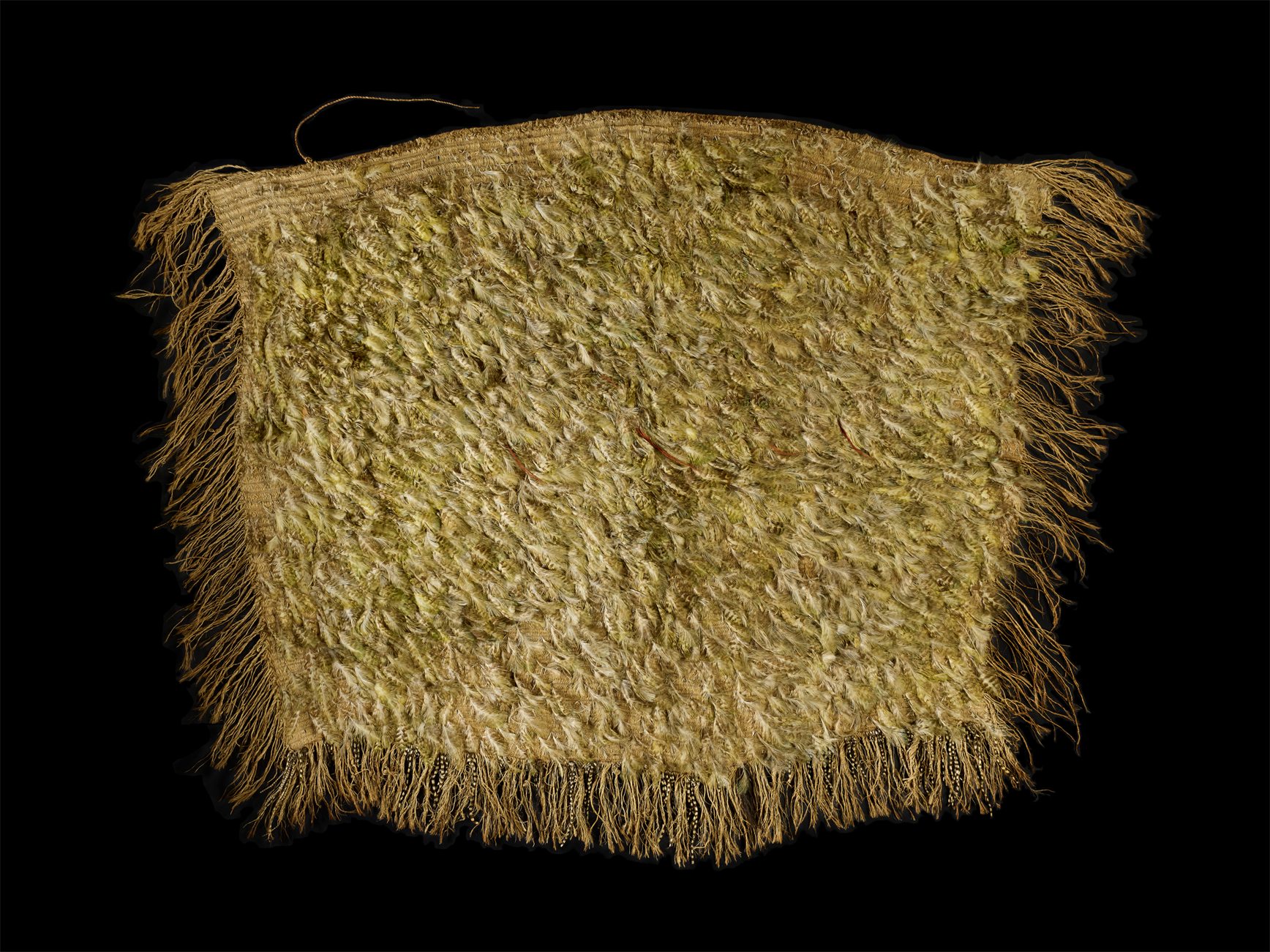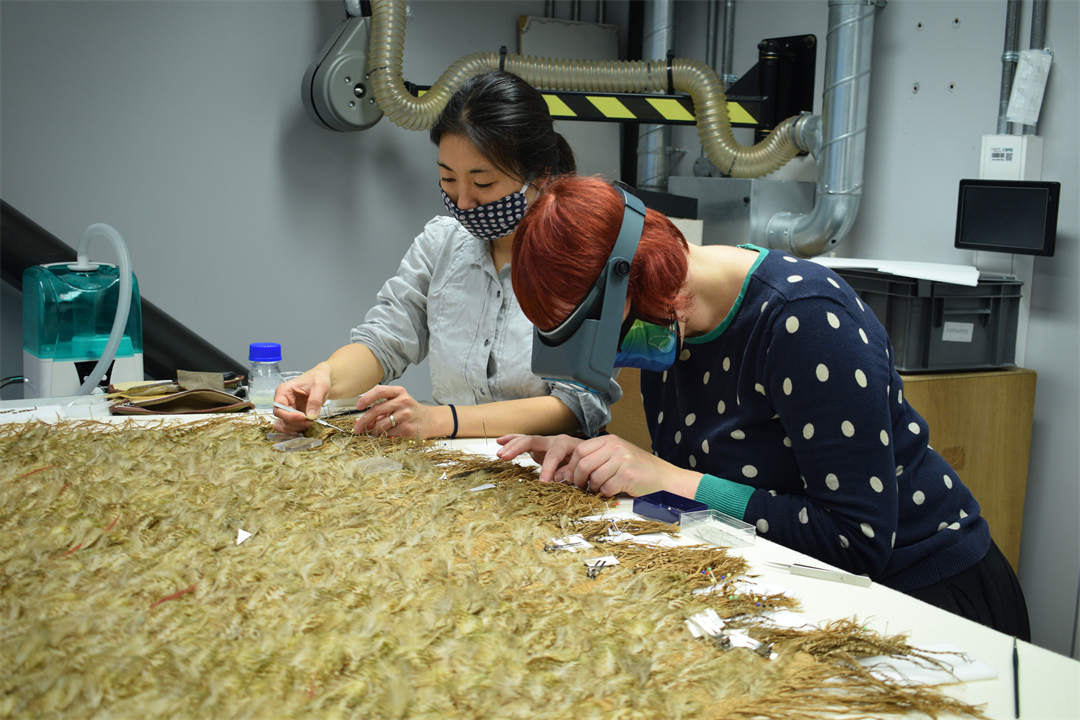Enter a search term above to search our website
Pages
News
Star Objects
Culture Perth and Kinross, in partnership with the British Museum and the Museum of New Zealand Te Papa Tongarewa, have preserved a unique example of a Māori cloak or kahu kākāpō (‘cloak of kākāpō feathers’) for future generations to enjoy after conducting vital conservation work. The cloak will go on display in the new Perth Museum being developed in Perth City Hall, set to open in the spring of 2024.
The cloak was treated in the British Museum conservation studios in London by conservators from the British Museum and Perth Museum and Art Gallery. The treatment was developed in partnership with Māori advisors to ensure it was culturally appropriate, and new findings about the cloak uncovered during treatment were shared with the Māori community and other interested parties.
The kahu kākāpō belongs to the class of feather cloaks or kahu huruhuru. It is named after the kākāpō, a flightless green ground parrot currently only found on four small islands off the coast of New Zealand that have been cleared of predators. This is the only such cloak covered fully in kākāpō feathers known to survive anywhere in the world.

The cloak was amongst several objects collected by David Ramsay, a Perth-born doctor who sailed to New South Wales, Australia, as a ship’s surgeon and eventually settled there as a merchant and farmer, part of Britain’s colonial expansion. How precisely he collected remains unclear but is the subject of on-going research. He donated his collection to the Perth Literary and Antiquarian Society in 1842. The Society’s collection was transferred to Perth Town council in 1914 when Perth Museum and Art Gallery was established.
The cloak has been designated as a key display item for the new Perth Museum. The kahu was fragile, having shed feathers and plant fibres and in danger of losing more material every time the cloak was handled. Perth Museum and Art Gallery contacted the British Museum for assistance with the cloak’s conservation, which the British Museum’s Organic Artefact Conservation was well-placed to give. The studio has many years of experience treating feathers and plant fibres. The conservators of both museums, along with Perth’s curatorial team member, Mark Hall, and Māori curatorial adviser Awhina Tamarapa (acting on behalf of Te Papa), devised and agreed on the treatments carried out.
During the project, valuable advice was also provided by the Ngāti Rānana London Māori Club, the New Zealand Society of Scotland, the Conservators at Te Papa, and conservation colleagues in the British Museum’s Organic Artefact conservation studio.
A British Museum UK Partnership Knowledge Share project was set up to support the collaboration. This programme promoted the sharing of skills between UK-based museum staff. It allowed Anna Zwagerman, Perth Museum and Art Gallery’s Conservation Officer, to spend three weeks in London to treat the cloak alongside British Museum conservators Misa Tamura and Nicole Rode.
In addition to skills sharing, one of the key aims was to include culturally appropriate care into the conservation process. Before the kahu kākāpō travelled from Perth to the British Museum for treatment, staff from Perth Museum and Art Gallery welcomed local and London-based Māori representatives to conduct a leaving ceremony for the kahu kākāpō.

Anna Zwagerman,right, and Misa Tamura, left
Once at the British Museum, the kahu kākāpō was welcomed by members of Ngāti Rānana. Both ceremonies allowed for the appropriate cultural practices to be observed but were also an opportunity for Ngāti Rānana members to look more closely at their taonga (Māori for ‘cultural treasure’).
The conservators started with a consideration of the support that was needed for the weak and damaged areas of the kahu. The main concerns were the stability of the feathers, as well as the pōkinikini – the cylindrical, dried strands made from harakeke, also known as New Zealand flax. The feathers of the kākāpō had been woven into the ground weave of the cloak by their exceptionally fine, thin shafts. Over time, some of the feathers had become bent, partially split at their shafts, or completely detached from the weave. To support them, a strong but lightweight mulberry paper was used. The treatment of the pōkinikini required similarly delicate hand skills. Over 100 hours of sustained focus and manual dexterity were required to support these fragile elements, along with super-fine tipped forceps and strong magnification. Finally, a custom mount for the cloak was made, shaped so it would not be visible on display before the cloak was ready to return to Perth.
From Culture Perth and Kinross, Anna Zwagerman and Mark Hall agreed that “This project was a wonderful opportunity to understand and conserve the kahu kākāpō and to develop closer links between Culture Perth and Kinross and Te Papa Tongarewa. From the beginning, our intention was to develop a new, collaborative understanding of Māori taonga within the Perth collections and to share that knowledge with the world.
As a result of the collaboration, empathetic networks of knowledge, skill, and professional best practice have now been established. The kākāpō cloak is a powerful, living force, and the careful conservation supported by the Māori community has served to underscore the kahu’s deep cultural significance and inspirational role in supporting Māori identity. It was a great privilege for us at Culture Perth and Kinross and the British Museum to contribute to the care of this fascinating and enduring taonga and to help ensure the kahu can take wing into a secure future that this taonga will help to mediate.”
A video summarising the project is available on YouTube:
Discover more about the kahu kākāpō in this blog from The British Museum, including more on the treatment and care of the cloak. https://blog.britishmuseum.org/caring-for-the-only-known-full-kakapo-feather-cloak-in-the-world/
The new Perth Museum being developed at Perth City Hall is due to open in Spring 2024. It will be managed in partnership between Perth and Kinross Council and Culture Perth and Kinross and is supported by £10 million from the UK Government as part of the Tay Cities Region Deal – a £700 million regional investment programme jointly funded by the UK and Scottish governments and regional partners.